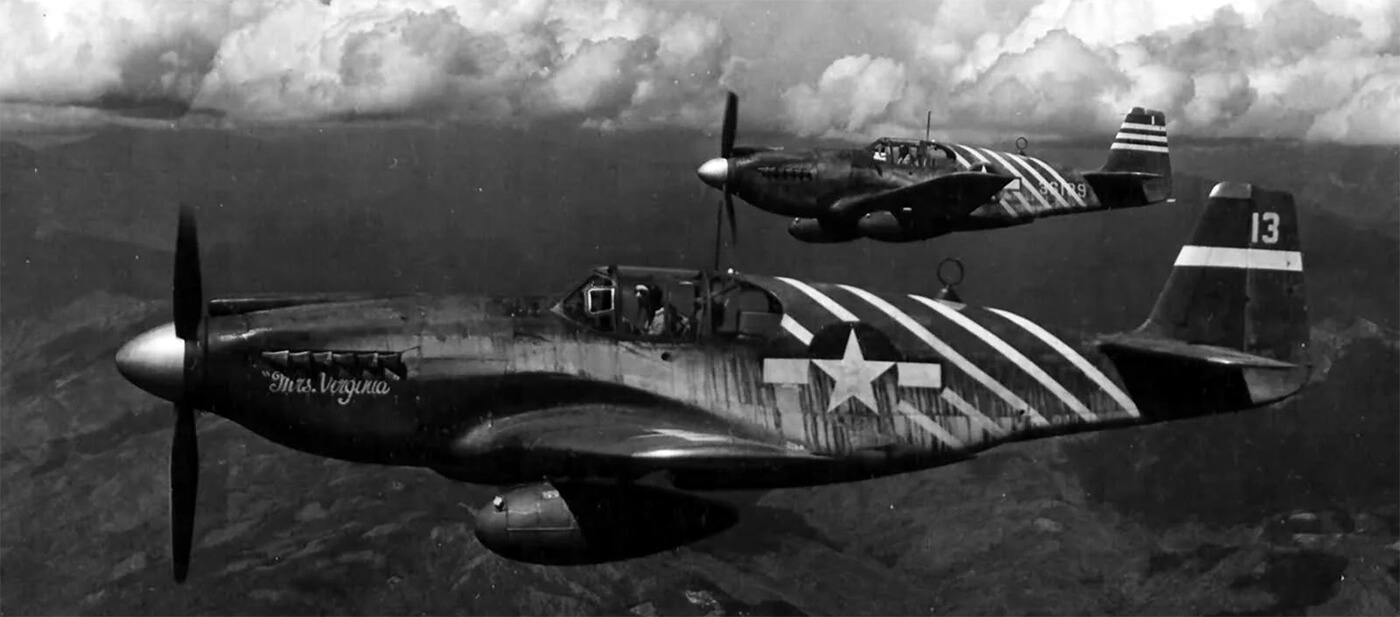| Page Created |
| February 9th, 2023 |
| Last Updated |
| February 17th, 2025 |
| Country |
 |
| Additional Information |
| Unit Order of Battle Commanders Operations Equipment Multimedia Sources |
| Operations |
| February 3rd, 1944 – March 4th, 1944 |
| 1st Air Commando Group |
| Combat air support mission. P-51’s and B-25’s of the fighter bomber unit. Their mission is to provide air support for the Chindits concentrating their flights on attacking Japanese lines of communication and increasing their air-to-ground. proficiency. On February 3rd, 1944, Colonel Cochran leads five Mustangs on the unit’s initial combat mission, and the B-25 section joins the fight on February 12th, 1944. The 1st Air Commando force flies a total of fifty-four fighter/bomber missions during this period. From the beginning, fighter and bomber missions concentrate on road and railroad bridges, warehouses, truck convoys, railroad locomotives, and river barges. As the assault section attacks these targets, their accuracy, proficiency, and selection of ordnance improves drastically. Just as crucial as the missions themselves is the intelligence that is collected during each flight. High-ranking Chindits joined the B-25 missions to identify and assess jungle clearings that could potentially be used during the invasion. They are assisted by a small detachment from the 10th Combat Camera Unit, who use handheld cameras to capture images. However, with no facilities for processing film, the commander of the unit, 1st Lieutenant Charles L. Russhon, must be creative. He develops the pictures at night in the open air, with a sentry standing guard to keep the area dark. A nearby well provides the necessary water. In addition to the photographs, the pilots report on enemy defenses, troop movements, and supply lines. This information, combined with the aerial images, was used by General Wingate’s staff to plan Operation Thursday. |
| February 4th, 1944 – February 26th, 1944 |
| 1st Air Commando Group |
| Support Mission. D Squadron Light Aircraft. Their mission is to support the XV Corps during the Japanese offensive known as Operation Hago or Operation Z. D Squadron becomes involved in the Battles of Admin Box. At the start of February, the British are caught in a Japanese counterattack and are in danger of being defeated. Admiral Mountbatten orders the British to hold their ground and be resupplied by air, and from February 4th until the end of the month, the British fought back and eventually won the battle. During that time, D Squadron, flying at low altitudes, keeps the British spirits high by delivering mail and newspapers, bringing in reinforcements, and evacuating the wounded. In total, the squadron safely removes almost seven hundred British soldiers to a rear airfield for transport on C-47 Dakotas. Air Marshal Sir John E. A. Baldwin, Commander of the 3rd Tactical Air Force, is so impressed by the bravery and skill of the light plane pilots that he makes a personal visit to offer his congratulations. |
| February 28th, 1944 – February 29th, 1944 |
| 1st Air Commando Group |
| Glider resupply Mission. Glider Unit, three WACO CG-4A gliders. Their mission is to deliver a patrol, folding boats, outboard engines, and gasoline to the 16th Brigade of the Chindits. On February 28th, 1944, a British patrol is loaded onto a Waco glider and towed across the Chindwin River. The glider is cut loose near Minsin. It suffers damage during the landing, is burned and the pilots had to return to India on foot. The next day, February 29th, 1944, two gliders are sent to assist the 16th Brigade of the Chindits, led by Brigadier Bernard E. Fergusson. The brigade has set off from Ledo on February 1st, 1944, and needs help crossing the Chindwin River. The gliders carry folding boats, outboard engines, and gasoline, and land on a sandbar in the river. After unloading the supplies, they are picked up by a C-47 crew and brought back to Lalaghat. |
| February 5th, 1944 – March 11th, 1944 |
| Operation Thursday (Insertion Phase) |
| 1st Air Commando Group, Chindits |
| Operation Thursday is launched on March 5th, 1944, by the air commandos of the United States to deliver troops, equipment, and supplies behind Japanese lines in Burma. The operation involves towing gliders and faces initial challenges due to the overloaded gliders causing problems for C-47 tow planes and ropes. However, the air commandos successfully deliver Wingate’s forces to the jungle clearings and improve the strips to facilitate safe landings. The air commandos also protect British ground forces by attacking and destroying the Japanese infrastructure using P-51’s and B-25’s equipped with a 75 mm cannon and twelve .50 caliber machine guns. Additionally, the air commandos conduct unique techniques such as cutting Japanese telephone lines by attaching a weighted cable to P-51s. The operation results in impressively low casualties and the successful evacuation of all killed, wounded, and sick behind enemy lines, leading to the Distinguished Unit Citation for the 1st Air Commando Group. The unit was responsible for bringing in 2,038 personnel, sixteen horses, 136 mules, and 50,000 kilograms of stores. Including the glider dispatched from Broadway, a total of eighty gliders were launched to Broadway and seventeen to Chowringhee. Personnel sent to the two landing strips by glider totaled 971. |
| February 5th, 1944 – August 27th, 1944 |
| Operation Thursday |
| 1st Air Commando Group, Chindits, Merrill’s Marauders |
| 3rd Indian Infantry Division (Chindits), Galahad (Merrill’s Marauders), No.1 Air Commando Force. Their mission is to set up operating bases and airfields behind Japanese lines to disrupt the Japanese supply lines. Operation Thursday was a World War II military operation launched in 1944 by the British Army and the American Office of Strategic Services (OSS) in Burma, with the objective of establishing a new airbase behind Japanese lines for the purpose of supporting ground forces. The operation involves the deployment of the Chindits, who are to establish a base in the jungle from which to launch guerrilla raids on Japanese supply lines. The operation is named Thursday as the plan was to launch the mission on a Thursday. The Chindits are supported by the 1st Air Commando Group, a US Army Air Force unit equipped with transport aircraft, fighters, and bombers. The 1st Air Commando Group drops supplies and reinforcements to the Chindits and conducts airstrikes against Japanese targets. The operation is successful in establishing a new airbase, and the Chindits are able to conduct a number of successful raids on Japanese supply lines, inflicting heavy losses on the enemy. However, the operation is also costly, with many casualties on both sides. The Chindits are eventually withdrawn after suffering heavy losses due to disease, malnutrition, and combat. Despite this, Operation Thursday is considered a significant achievement and paves the way for further Allied advances in Burma. |
| April 4th, 1944 |
| 1st Air Commando Group |
| Attack on Japanese Airfield Heho. Fighter Squadron of the 1st Air Commando Group. The commando assault force responds to intelligence reports of Japanese movement in the Rangoon area. Departing at 0800, they head for Aungban, Burma. However, the Japanese already scrambled their fighters from Heho in anticipation of a P-38 attack from the USAAF 459th Squadron. By the time Lietenant Colonel Mahoney’s P-51A Mustangs arrive over the airfield, the Japanese aircraft are parked in revetments. The commandos use rockets to keep the anti-aircraft batteries at bay while strafing the field repeatedly, destroying four medium bombers and twenty fighters on the ground. In the air, Captain Forcey engages an enemy aircraft, making a pass within 200 metres before pulling off. The Japanese fighter catches fire and explodes. On their way back, the fighters also destroy an enemy bomber on the ground at Anisakan. Overall, the mission resulted in twenty-six verified enemy kills, with no P-51A Mustangs lost by the air commandos. |
| April 21st, 1944 – April 26th, 1944 |
| Search and Rescue Operation. |
| 1st Air Commando Group |
| Sikorsky YR-4B 43-28223 of the 1st Air Commando Group flown by Lieutenant Carter Harmon. His mission is to rescue Technical Sergeant Ed “Murphy” Hladovcak and three Chindits after crashing his Stinson L-1A Vigilant liaison aircraft behind enemy lines. All four men are rescued over a period of two days by helicopter, making it the first helicopter search and rescue mission. |
| March 15th, 1945 |
| 1st Air Commando Group |
| Forty P-51D Mustangs of the 1st Air Commando Group armed with drop tanks attack Don Muang airfield. They manage to destruct of at least 50% of the one hundred Japanese aircraft stationed there. |
| April 9th, 1945 |
| 1st Air Commando Group |
| 33 Mustangs of the 1st Air Commando Group armed with drop tanks. Their mission is to attack Don Muang airfield. Three Mustangs are shot down due to heavy anti-aircraft fire. |
| May 1st, 1945 – May 6th, 1945 |
| Operation Dracula |
| 1st Air Commando Group, 2nd Air Commando Group, 44th Indian Airborne Division |
| By April 1945, the British Fourteenth Army advances to within sixty-four kilometres of Rangoon but is delayed until May 1st, 1945, by an improvised Japanese force defending Pegu. On the same day, as part of Operation Dracula, a composite Gurkha parachute battalion lands at Elephant Point at the mouth of the Rangoon River. After securing the coastal batteries, minesweepers clear the river of mines. The operation is supported by the U.S. 1st and 2nd Air Commando Group. The following day, the Indian 26th Infantry Division begins landing on both sides of the river. The monsoon breaks earlier than anticipated, but the Japanese have already abandoned Rangoon, allowing the Indian 26th Infantry Division to occupy the city and its docks without resistance. Four days later, they link up with the Fourteenth Army. The British suffer casualties when B-24 Liberators from the U.S.A.A.F. mistakenly target C Company, leading to 15 soldiers killed and 30 wounded. In the subsequent assault on Japanese positions, the battalion incurred an additional 41 casualties. Approximately 40 Japanese defenders were killed during this engagement. |

